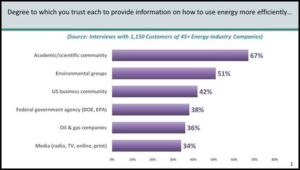
CERAWeek, the annual conference of the international energy industry in Houston, has always been a barometer of sorts for the state of the industry and its challenges and it’s less than a month away.
A recurrent theme of interest to us as marketing scholars is that energy leaders, battling an all-time low level of trust, have been devising new ways to get the public back on their side.
Seven years ago, during the 2012 CERAWeek, then-Shell CEO Peter Voser said, “We need to do a better job of listening and responding. As an industry, we should insist on strong regulation and enforcement to ensure everyone in the industry does the right job.”
Yet a 2014 survey of over a thousand U.S. residents showed that the trust gap only widened after these remarks were made. Asked how much faith they had in oil and gas companies to provide information on conserving energy, less than one in five ranked these companies as very trustworthy. In contrast, federal agencies like the Department of Energy and the Environmental Protection Agency were perceived as trustworthy by 24 percent, while environmental groups and the academic/scientific community were rated as trustworthy by nearly half of those surveyed.
Have things improved since then? In early 2018, we surveyed 1,150 managers, employees and executives of companies that buy goods and services from energy companies like BP, Exxon Mobil, General Electric, Halliburton, Shell and Schlumberger. As these respondents are energy industry insiders, we expected them to strongly trust oil and gas companies to provide information on how to use energy more efficiently. But only 36 percent trusted their own industry suppliers to provide such information. Almost twice as many — 67 percent — trusted the academic/scientific community to provide such information, and 51 percent trusted environmental groups.

Most energy industry leaders believe this trust deficit can be fixed through a robust communication strategy. Some advocate educating their customers and the general public, while others advocate more transparency and disclosure. “We need to fully disclose chemical compositions,” Anadarko’s then-CEO, Jim Hackett, declared at the 2012 CERAWeek conference.
Decades of psychological research, however, reveals that when a source’s credibility is low, people are unlikely to believe the information provided by that source — no matter how accurate. If their customers already distrust them, energy companies cannot bridge the trust gap by providing more information, being more transparent or educating their customers. Since neither the general public nor their own customers trust them, any information, education and transparency efforts companies undertake are going to fall flat.
But there is a solution. For energy-related information, customers of energy industry companies trust both the academic/scientific community and environmental groups. To build trust with their own customers, then, energy industry companies need to build strong relationships with trusted stakeholders — in this case, the academic and scientific community and environmental groups. If these trusted stakeholders are deeply involved in conducting research and providing useful guidance, then perhaps energy industry companies can gain the trust of their own customers and the general public.
To do this, CEOs of energy companies need to re-evaluate their current approach of providing information directly to their customers, and switch to ensuring that information is provided by a trusted source. Energy companies have not earned the designation of being a trusted source, but they can get there by collaborating with institutions that have.
Vikas Mittal is the J. Hugh Liedtke Professor of Marketing at the Jones Graduate School of Business. at Rice University. Shrihari Sridhar is the CED Professor of Marketing, Presidential Impact Fellow, and Associate Professor of Marketing, and Research Director of the Professional Selling Initiative at Texas A&M’s Mays Business School.

